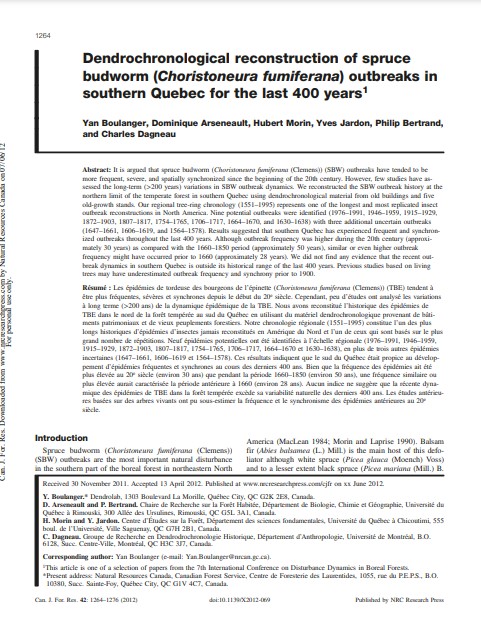Dendrochronological reconstruction of spruce budworm (Choristoneura fumiferana) outbreaks in southern Quebec for the last 400 years1
Bosque Modelo:
Bas-Saint-Laurent
Temática:
Conservación
Tipo de documento:
Artículo científico
Resumen
It is argued that spruce budworm (Choristoneura fumiferana (Clemens)) (SBW) outbreaks have tended to be more frequent, severe, and spatially synchronized since the beginning of the 20th century. However, few studies have assessed the long-term (>200 years) variations in SBW outbreak dynamics. We reconstructed the SBW outbreak history at the northern limit of the temperate forest in southern Quebec using dendrochronological material from old buildings and five old-growth stands. Our regional tree-ring chronology (1551–1995) represents one of the longest and most replicated insect outbreak reconstructions in North America. Nine potential outbreaks were identified (1976–1991, 1946–1959, 1915–1929, 1872–1903, 1807–1817, 1754–1765, 1706 1717, 1664–1670, and 1630–1638) with three additional uncertain outbreaks (1647–1661, 1606–1619, and 1564–1578). Results suggested that southern Quebec has experienced frequent and synchronized outbreaks throughout the last 400 years. Although outbreak frequency was higher during the 20th century (approximately 30 years) as compared with the 1660–1850 period (approximately 50 years), similar or even higher outbreak frequency might have occurred prior to 1660 (approximately 28 years). We did not find any evidence that the recent outbreak dynamics in southern Quebec is outside its historical range of the last 400 years. Previous studies based on living trees may have underestimated outbreak frequency and synchrony prior to 1900.
Información Bibliográfica
Autor:
Boulanger Y and D Arseneault.
Revista:
Canadian Journal of Forest Research
Año:
2004
N°:
-
País :
Canadá
Páginas:
1035 - 1043
Volumen:
34
Idioma:
Ingles
Palabras claves
Model forest, Adaptatation





